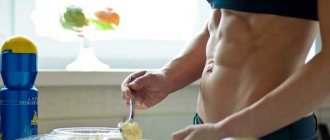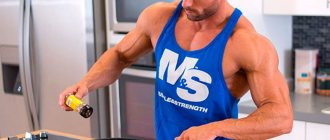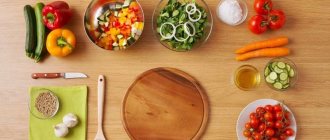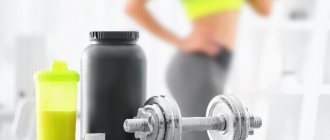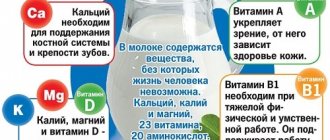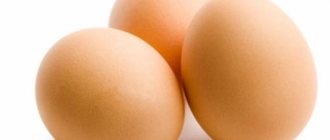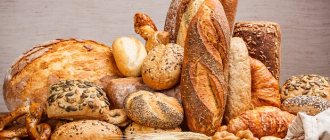It so happened, and it’s good that cottage cheese has become the single most affordable protein-containing product for athletes. Due to its amino acid composition, a dairy product is not only a product of a healthy lifestyle, but also a product of gaining/maintaining muscle mass.
Today we'll talk about cottage cheese. We’ll discuss which cottage cheese is best for you, based on the athlete’s goals, and also share a couple of interesting fitness recipes.
Cottage cheese: one of the favorite dishes of athletes
Cottage cheese, as mentioned above, is a unique product in its amino acid composition, which contains the amino acids necessary for gaining muscle mass. In addition, cottage cheese is absorbed by the human body better than meat. It is softer and more tender than most other high protein products.
The only problem with cottage cheese is that some people suffer from dairy intolerance.
Compound
Cottage cheese plays an important role not only in medical nutrition, but also in sports nutrition. For those who regularly exercise, cottage cheese is the number one product. The product is dominated by milk protein casein, which takes a long time to be absorbed in the body (about 4-5 hours), thereby charging the body with energy for a long time. In addition, cottage cheese contains a rapidly disintegrating protein, which makes it possible to consume it after intense physical exercise.
How is cottage cheese good for athletes? Protein, although the main component of cottage cheese, is far from the only one. In addition, it contains vitamins B, A, C and PP, which are necessary for an athlete to maintain immunity and the coordinated functioning of the whole body. And the increased concentration of minerals (calcium, phosphorus, magnesium, potassium, zinc, iron) supports the musculoskeletal system and helps avoid injuries when playing sports.
Homemade cottage cheese, fatty cottage cheese: what is the difference for sports.
Among the types of cottage cheese, the following are found on the shelves: fat and low-fat. Below Power-fit.ru looked at which is better to use cottage cheese for gaining muscle mass and drying the body.
The difference between them is not only in the percentage of fat content, but also in the amount of protein per 100 grams of substance. Low-fat cottage cheese has more protein, fatty cottage cheese has less.
This does not mean that low-fat cottage cheese is better, fatty cottage cheese is good for the initial stages of weight loss and fat burning. 9% cottage cheese is more filling, thanks to which you can calm your appetite for a long time. But you shouldn’t get too carried away with fatty cottage cheese, otherwise the body will use these fats as the main fuel, and then the diet or fat burning will come to naught. After all, 1 gram of fat contains 9 calories.
At the same time, dry cottage cheese, that is, low-fat cottage cheese, is better suited as a natural and healthy substitute for protein powder. “Adopt” after training to use low-fat cottage cheese as a dinner, and also immediately after training to close the protein-carbohydrate window.
And if you are training for weight, then any type of cottage cheese will do. The main thing is not to starve!
How to distinguish a fake?
It is easy to distinguish fake cottage cheese: you need to add a drop of iodine to the curd mass. The color has not changed - the product does not contain starch. If the product turns blue, purple or other colors, the manufacturer has reduced the cost of producing the product with starch.
With palm oil it’s a little more difficult, but you can check: adding oil greatly increases the shelf life of the product and makes it cheaper. A kilogram of cottage cheese cannot cost less than 2.5 liters of milk.
The best choice is to buy cottage cheese on the market . Few people there will bother adding starch or palm oil, and most village grandmothers don’t have such technologies.
An alternative is proven cottage cheese from famous brands. They value their reputation and make money through the high quality of their products.
What types of cottage cheese are there:
1. Store-bought full-fat cottage cheese [9% fat] 2. Store-bought low-fat cottage cheese [0% fat] 3. Homemade fat-free cottage cheese 4. Homemade low-fat cottage cheese
When you buy homemade cottage cheese, don’t even ask the seller how much fat it contains. The sellers are most likely newcomers and will just throw up their hands, because, really, how would they know?
In store-bought cottage cheese, the fat content is accurate, but you don’t know what kind of milk it was made from. Most often, such cottage cheese is made from powdered milk.
What products are fermented milk
All over the world, fermented milk is considered to be any product made from milk, not necessarily cow's milk, in the creation of which bacteria capable of producing lactic acid took part. Different strains of lactobacilli and streptococci can do this - both wild and cultivated, that is, those that people grow specifically for fermented milk production.
There are a great variety of fermented milk products themselves and the bacteria that “know how” to produce them. However, they are all prepared in a very similar way - although the methods differ in different countries.
For example, residents of Indonesia make national “kefir” - dadih - from buffalo milk - it is poured into a bamboo tube, covered with a banana leaf and left for a couple of days at room temperature. “Wild” lactic acid bacteria Lactobacillus plantarum grow independently in milk, eat the milk sugar lactose and secrete lactic acid and some other substances like carbon dioxide and acetic acid. All this gives dadikh a pleasant sourness.
In approximately the same way - except that cultural strains of lactic acid bacteria are involved in the process, and the process itself takes place under sterile conditions in specialized production facilities - all sour cream, yoghurts, kefir and cheeses that can be found in stores are prepared. The difference between the products lies in the nuances of technology, the fat content of the milk base and the strains of specific microorganisms that participate in the process. For example, sour cream is made only by lactobacilli, yogurt by lactobacilli and streptococci, and, for example, koumiss by lactobacilli and yeast.
In our country (of course) there is GOST 33491-2015, which defines what exactly Rosstandart agrees to consider fermented milk products. These are kefir and kefir products based on kefir cultures or fungi, yogurt, matsoni, fermented baked milk, sour cream and yogurt.
All of these products must be made from cow's milk or cream through fermentation, which involves "starter microorganisms regulated for each product." And these products must be enriched with bifidobacteria bifidum, the concentration of which must be at least 106 live microbial cells or colony-forming units (CFU) per gram of product. We will tell you why it was necessary to enrich fermented milk with bifidobacteria a little later.
How much protein is in 100 grams of cottage cheese:
Cottage cheese is one of the most amino acid-rich foods in the world. Below we will prove why:
— For 100 grams of low-fat cottage cheese there are 16.5 grams of protein.
— 100 grams of full-fat cottage cheese contains about 14 grams of protein.
It's up to you to decide which cottage cheese is best for you. It all depends on your goals.
As we mentioned above, fatty cottage cheese can fill you up well and stave off hunger. But by eating a lot of fatty cottage cheese, you will stop the fat burning process, while you can eat as much as you like on low-fat cottage cheese. More fat means more calories, less fat means fewer calories.
If you are overweight, then in the initial stages, focus on full-fat or half-fat cottage cheese. But it’s better not to eat such cottage cheese at night. You may experience heaviness in your stomach or intestines.
If the percentage of fat in the body is not very high, then it’s time to switch to low-fat cottage cheese. But there is a nuance here. If the weather is warm, then you can survive on low-fat cottage cheese for a long time, but if it’s cool, then cutting down calories and disdaining sweet healthy foods: fruits, honey; You risk losing your temper and starting to binge on food waste [chips, crackers, fast food] again. But if your motivation is very strong, then low-fat cottage cheese will help. Feel free to have dinner with it before bed.
Try to diversify your menu, otherwise, no matter what goals you set for yourself, the monotony of foods will sooner or later push you to a breakdown and you will start eating everything.
Cottage cheese before training: optimal time and quantity
Those who want to get their body in shape should definitely consume cottage cheese. But how exactly to eat it, when, in what quantities? Before we figure out whether it’s possible to eat cottage cheese after a workout, let’s find out how to eat it before the training process.
Cottage cheese is very good to consume before sports activities. However, besides it, other products cannot be discounted. You can eat some lean meat (chicken, rabbit, beef, veal, turkey). Seafood, fish and chicken eggs work well. All of these products contain a large number of nutritional components that help the athlete actively train. But the digestibility of cottage cheese is many times greater than all other snack options, so give preference to it.
For weight loss
In order to lose weight while staying active, our body requires a lot of energy. But this energy must be slow and pure. Otherwise, if you start to consume an abundance of fast carbohydrates and fats before training, you will ultimately not get any effect. Cottage cheese will help replenish energy reserves without depositing new lipids on the stomach and thighs.
If the main goal of sports activities is to lose excess weight or, especially, to fight obesity, then you should choose a low-fat product and eat it no later than one and a half to two hours before going to the gym. Consumption of excessive amounts of fat during this period is generally contraindicated. At the same time, do not forget that it does not hurt to choose a fractional diet option, in which the portions of cottage cheese need to be reduced, but, on the contrary, the number of meals per day should be increased.
For weight gain
In order to build beautiful, voluminous muscles, the body will need a large amount of building material - proteins. Carbohydrates will also help him, and he will also have to worry about the minimum amount of fat. All these points are more than covered by natural cottage cheese. The main thing is to ensure that it is not overly greasy. It is recommended to consume it one and a half hours before training.
To understand how much cottage cheese to eat after or before a workout, in order to acquire beautiful muscles, you need to understand the proportions. The optimal amount is two grams for every kilogram of the athlete's weight. In this case, it is recommended to divide meals into six or even eight meals. True, not everyone can afford to eat in this mode, so it is acceptable to eat four or five times a day.
Drying
During the drying process, which you can read about in a separate article on our website, you need to reduce fats in your diet to the bare minimum. It would be possible to use a strict diet, like the revolutionary “1200 calories”, but it is completely unsuitable for active sports practiced during this period.
The best option for this process would be low-fat cottage cheese. It should be consumed two hours before going to the gym. It is important not to add any additives, flavors or sweeteners to it. It is not recommended together with fruits, berries or other fillers.
Cottage cheese recipes for weight loss and weight gain:
For further motivation, Power Fit presents a mouth-watering selection of cottage cheese recipes.
Classic protein: milk, cottage cheese, bananas.
To prepare this dish you will need:
- 100 grams of cottage cheese - 2 ripe bananas. - 1-2 glasses of milk.
Mix the ingredients in a mixer until thick and liquid. It is advisable to use full-fat cottage cheese, and add milk gradually so as not to turn your thick protein shake into a liquid one.
Experiment with serving sizes. You understand - different portions are obtained for men and women. If you want less carbohydrates, add less banana. If you want more protein, more cottage cheese.
This cocktail is perfect at any time of the day, as well as immediately after training to close the protein-carbohydrate window.
Homemade weight gainer: cottage cheese with condensed milk.
Cottage cheese with condensed milk is a super-easy dish to prepare. Prepared in a hurry.
- 100 grams of cottage cheese. - Condensed milk to taste.
The recipe is simple. Place the cottage cheese on a plate and pour over condensed milk. Is our cottage cheese with condensed milk ready?
The dish is suitable for those athletes who train to gain muscle mass. You can safely eat both before and after training.
Fitness salad: cottage cheese, eggs, chicken breast and a little salt.
What can I say, before your eyes is a recipe for a real fitness salad. Not sweet, and will work as a variety for a side dish.
- 200 grams of cottage cheese. - 2 hard-boiled eggs. - from 100 grams of boiled chicken breast. - salt and spices to taste.
Cooking: it’s up to you to decide which cottage cheese is best suited for salad.
Finely chop the meat, peel the eggs and grate them. Place cottage cheese, eggs and meat in a bowl. Add salt and your favorite spice to taste. Maybe mayonnaise. Greens will also serve as a good addition to this dish: finely chopped dill or parsley.
Mix all the ingredients and our fitness salad is ready!
Fitness cheesecakes from Denis Seminikhin: get your 50 grams of protein.
← Previous material
Next material →
What's the result?
- Fermented milk can be called any product that is made from milk and in the production of which lactic acid bacteria (and other microorganisms) participated.
- Fermented milk products are harmless to healthy adults and, unlike pure milk, can be consumed by some people with lactose intolerance. But there are also limitations: for example, fermented milk is not recommended for patients with serious immune problems (like AIDS), people with an allergy to milk protein (although bacteria break it down, some still remains).
- In accordance with GOST, Rosstandart requires that Russian fermented milk products be enriched with bifidobacteria. This is a good idea - there is evidence that bifidobacteria, along with lactic acid bacteria, promote gut health. And perhaps protect against colds.
By-effect
Here we come to this unpleasant surprise. For many, it is truly contraindicated due to individual intolerance. In addition, excessive consumption of cottage cheese significantly burdens the kidneys due to excess protein.
The conclusion suggests itself - use moderation, but many athletes from the world of fitness and bodybuilding exclude this dairy product. Why? This is due to the fact that cottage cheese, like other dairy products, retains water in the body. Consequently, there will be no relief, the weight has frozen, I am tormented by bloating, and the swelling under the eyes has become larger. To check which group of people you belong to, give up all kinds of milk for a month and compare the results. If the condition of the body and skin remains unchanged, then it is not the milk.
Fasting day on cottage cheese
Experts recommend spending a fasting day on cottage cheese once a week. For people whose weight significantly exceeds the norm, you can do unloading twice in 7 days to lose weight. There are several menu options for such a day, but the principle of fractional meals is always respected. To prepare your body for weight loss, do not eat heavy or fatty foods the day before. The following options for fasting days can be mentioned:
- 1 kg of cottage cheese and 2 liters of water or herbal tea;
- cottage cheese – 500 g, lean meat – 200 g, water – 2 l;
- cottage cheese – 600 g, berries – 1 glass, water – 2 l;
- cottage cheese – 500 g, kefir (milk) – 0.5 l.
